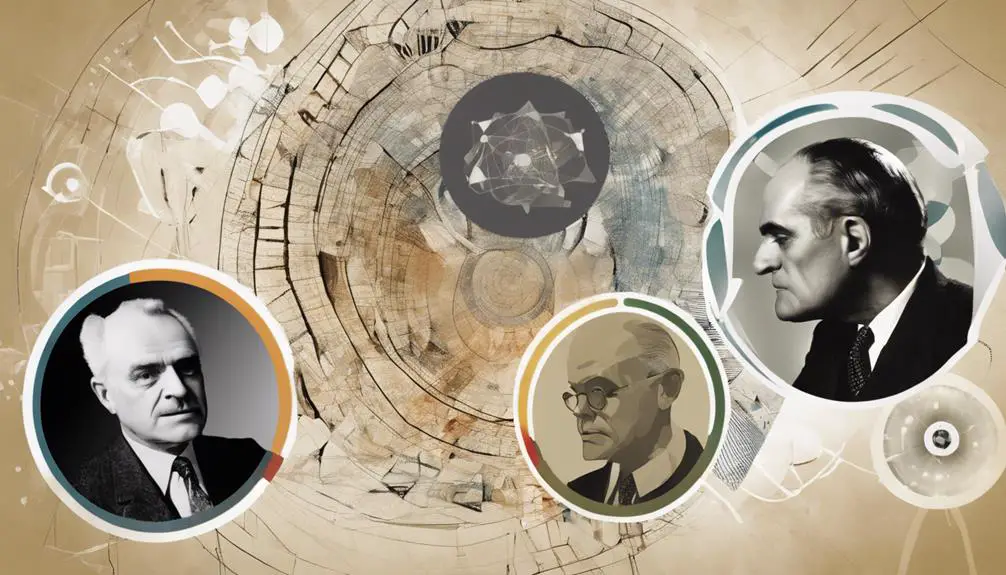Origins of Hypnosis Timeline
7 Tips for Understanding Hypnotherapy Techniques Through History
October 10, 2017 - Origins of Hypnosis Timeline
Discover the intriguing evolution of hypnotherapy by exploring its ancient origins in civilizations like Egypt and Greece. Dive into Mesmer's magnetic therapy techniques that paved the way for inducing trance-like states. Learn about James Braid's revolutionary hypnotic induction methods emphasizing the power of suggestion. Explore Sigmund Freud's impact on modern hypnotherapy practices through his theories on the unconscious mind. Uncover the innovative approaches of modern pioneers such as Milton H. Erickson and Dave Elman. Each historical milestone contributes to the rich tapestry of hypnotherapy techniques.
Ancient Roots of Hypnosis

Tracing back through history, the origins of hypnosis can be found intertwined with ancient healing practices and spiritual rituals. Ancient civilizations such as the Egyptians, Greeks, and Romans utilized various forms of hypnotic rituals for both cultural and therapeutic purposes. These ancient practices held significant cultural significance, often involving trance-like states induced through chanting, music, or guided visualization.
Hypnotic rituals in these early societies were not only a means of healing physical ailments but also a way to address mental and spiritual imbalances. Shamans and healers would guide individuals into altered states of consciousness to access deeper parts of the mind, believed to hold the key to healing. The therapeutic benefits of these practices were evident in the relief of symptoms, the resolution of emotional traumas, and the restoration of balance within the individual.
Understanding the ancient roots of hypnosis provides insight into the enduring appeal and effectiveness of hypnotherapy techniques in modern times. The rich history of hypnotic practices serves as a foundation for the development of contemporary therapeutic approaches that continue to harness the power of the subconscious mind for healing.
Mesmer's Magnetic Therapy
Exploring the historical development of hypnotherapy techniques, an important milestone emerges with the introduction of Mesmer's Magnetic Therapy in the late 18th century. Mesmer, a physician from Austria, believed in the concept of 'animal magnetism,' asserting that there was an invisible energy transference between individuals that could be harnessed for healing purposes. This theory laid the foundation for what would later be recognized as energy healing practices.
Mesmer's Magnetic Therapy involved inducing a trance-like state in patients by using hand gestures and touch to realign their supposed magnetic fields. By doing so, he aimed to alleviate symptoms and promote overall well-being.
Though Mesmer's methods were later discredited in the scientific community, his influence on the development of hypnotherapy cannot be overlooked. His approach sparked further exploration into the power of suggestion, altered states of consciousness, and the subconscious mind, all of which are integral aspects of modern hypnotherapy techniques.
Mesmer's work paved the way for future researchers and practitioners to delve deeper into the therapeutic potential of the mind-body connection.
James Braid and Hypnotherapy

James Braid, a Scottish surgeon, made significant contributions to the field of hypnotherapy through his innovative research and clinical applications. Braid's key focus was on developing effective hypnotic induction techniques to induce a trance state in patients.
Unlike Mesmer's magnetic therapy, Braid emphasized the power of suggestion and the psychological aspects of hypnosis. Braid's methods involved guiding patients into a trance state through a series of verbal instructions and focusing techniques rather than relying on external forces.
By understanding the importance of suggestion and the mind's susceptibility to influence, Braid revolutionized the practice of hypnotherapy. His work laid the foundation for modern hypnotherapy techniques, emphasizing the role of the subconscious mind in shaping behaviors and perceptions.
Braid's contributions continue to influence hypnotherapy practices today, with his emphasis on the power of suggestion and the ability to access the subconscious for therapeutic purposes.
Sigmund Freud's Influence
Sigmund Freud's pioneering work in psychoanalysis profoundly influenced the development and application of hypnotherapy techniques. Freud's theories on the unconscious mind, repression, and the significance of early childhood experiences laid the foundation for understanding the power of the subconscious in shaping behavior and thought patterns.
One of Freud's key contributions to the field was highlighting the connection between psychoanalysis and hypnosis, recognizing that both methods aimed to access and address hidden aspects of the psyche.
Freud's exploration of the unconscious mind and his emphasis on the role of repressed memories and desires paved the way for modern hypnotherapy practices that seek to uncover and resolve underlying psychological issues. By acknowledging the influence of past experiences on present behavior, Freud provided a framework that hypnotherapists continue to build upon today.
The psychoanalysis connection remains a vital aspect of hypnotherapy, guiding practitioners in helping clients navigate their subconscious to promote healing and personal growth.
Modern Hypnotherapy Pioneers

In the realm of hypnotherapy, contemporary innovators have propelled the field forward through their unique approaches and contributions. Through dedicated hypnosis research and advancements in hypnotherapist training, modern pioneers have expanded the understanding and application of hypnotherapy techniques.
One notable figure in modern hypnotherapy is Milton H. Erickson, who revolutionized the field with his innovative approaches to hypnosis. Erickson's emphasis on utilizing indirect suggestions and adapting techniques to individual clients' needs has greatly influenced modern hypnotherapy practices. His work continues to inspire current practitioners to explore new ways of utilizing hypnosis for therapeutic purposes.
Another significant pioneer is Dave Elman, known for his structured and systematic approach to hypnotherapy. Elman's methods, particularly his rapid induction technique, have become foundational in hypnotherapy training programs worldwide. His contributions have not only shaped the way hypnotherapy is taught but have also enhanced the effectiveness of therapeutic interventions using hypnosis.
These modern hypnotherapy pioneers have left a lasting impact on the field, paving the way for continued growth and innovation in the practice of hypnotherapy.
Evolution of Hypnotherapy Techniques
The evolution of hypnotherapy techniques has been marked by a continual refinement and adaptation of methods to enhance therapeutic outcomes for clients. Originating from ancient healing practices and mesmerism, modern hypnotherapy has evolved significantly.
In the early stages, hypnotherapy was intertwined with mystical beliefs and misconceptions, but over time, it has become a respected psychological tool. One key aspect of this evolution is the understanding and utilization of hypnotic suggestions.
Hypnotic suggestions are tailored messages delivered to the subconscious mind during a hypnotic state. These suggestions can influence behavior, thoughts, and emotions, allowing for positive changes in the client's mindset. As hypnotherapy techniques have progressed, practitioners have honed their skills in crafting and delivering these suggestions effectively.
Contemporary Applications of Hypnosis

Current applications of hypnosis demonstrate its versatility and effectiveness in addressing a wide range of psychological and behavioral concerns. In contemporary times, hypnosis is increasingly recognized for its clinical benefits and therapeutic uses across various fields.
In clinical settings, hypnotherapy is utilized to help individuals manage stress, alleviate anxiety disorders, overcome phobias, and even aid in pain management. Therapists often integrate hypnosis into treatment plans for conditions such as depression, insomnia, and post-traumatic stress disorder (PTSD), enhancing the overall efficacy of traditional therapeutic approaches.
Moreover, hypnosis has proven to be valuable in behavioral interventions, assisting individuals in modifying unwanted habits like smoking cessation, weight management, and improving self-esteem. The technique's ability to tap into the subconscious mind enables therapists to work on deep-rooted issues that may not respond as effectively to other forms of therapy.
Frequently Asked Questions
How Does Hypnotherapy Differ From Traditional Therapy Methods?
Hypnotherapy differs from traditional therapy methods by utilizing trance-like states to access the subconscious mind. Benefits include targeted behavior change, while drawbacks may involve limited scientific validation. Effectiveness lies in addressing deep-rooted issues, yet limitations exist in individual responsiveness.
Can Anyone Be Hypnotized, or Is It Only for Certain People?
Individual susceptibility is key in hypnosis. Despite misconceptions, most people can be hypnotized to some degree. Factors like focus, trust, and suggestibility play a role. A skilled practitioner can guide almost anyone through hypnotherapy.
Are There Any Risks or Side Effects Associated With Hypnotherapy?
When considering hypnotherapy, it's important to understand the potential risks and precautions involved. Common side effects are mild, such as drowsiness. Misconceptions about losing control or revealing secrets are unfounded in professional hypnotherapy settings.
How Long Does It Typically Take to See Results From Hypnotherapy?
Patient expectations, practitioner experience, individual responsiveness, and session frequency all contribute to the timeline for seeing results from hypnotherapy. Typically, noticeable improvements can be observed within a few sessions, but results vary.
Is Hypnotherapy a Scientifically Proven Technique for Treating Various Conditions?
Hypnotherapy is a scientifically proven technique for treating various conditions. Research findings support its effectiveness for issues like anxiety, phobias, and pain management. Although debates and controversies exist, many studies demonstrate its positive impact on mental and physical health.
Conclusion
In conclusion, understanding the history of hypnotherapy techniques provides valuable insight into the evolution of this practice. From its ancient roots to modern applications, hypnotherapy has been shaped by influential figures such as Mesmer, Braid, and Freud.
By exploring the origins and development of hypnosis, individuals can gain a deeper appreciation for the therapeutic benefits it offers today.
